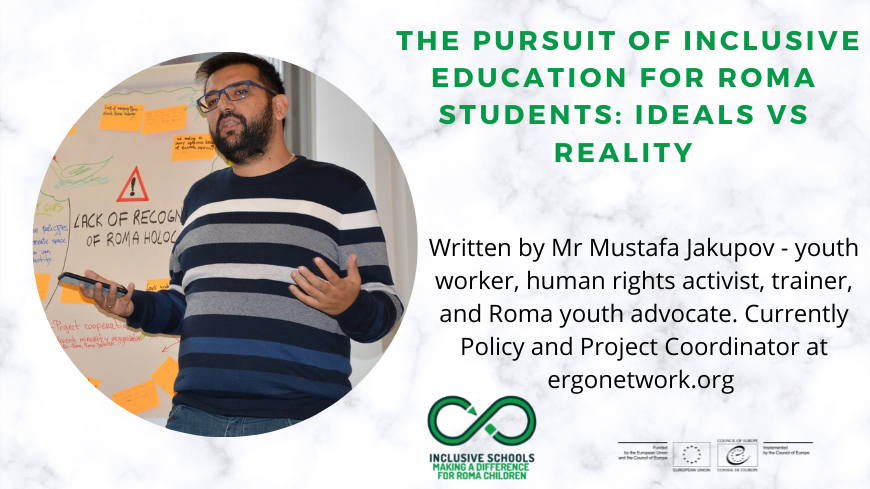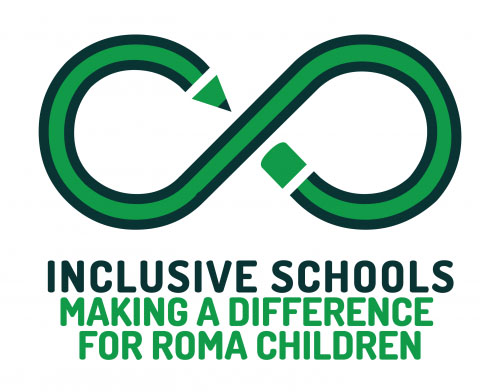Inclusive education acknowledges the fact that the classroom is filled with diverse learners coming from diverse backgrounds. When inclusion is done well, every student benefits from it. It strengthens the ability of every student to work well with other students, understand and value different points of view, think critically, and be an effective learners. Inclusive education reduces stigma.
The lack of understanding of the concept of inclusive education and its importance for Roma students still represents a major obstacle in offering equal opportunities for ALL. The absence of Roma language, history, and culture in schools’ curricula across Europe create further division among students, moving further away from European values based on solidarity, understanding and respect for diversity.
From an early age, many Roma students are not provided with equal learning opportunities to their majority peers, as most of the time the barriers raised by the vicious circles of poverty and anti-gypsyism stops them in accessing education[1].
On the one hand, lack of majority language skills, limited access to early childhood education and care, and a state of poverty which does not allow for proper studying at home, mean that Roma pupils are sometimes placed in schooling for children with learning disabilities. Additionally, segregated educational establishments breed a sectioned view of society, which fuels inequalities and discrimination This created a belief of Roma intellectual incapacity, leading towards exclusive education, where Roma children would receive basic educational support and most of the time end with placement in segregated schools. E.g., during the communist period, the separation of Roma children in schools was actively promoted in some countries (Hungary and Bulgaria); while other countries (Slovakia, Czech Republic) would aim to justify school segregation with inadequate data,; or some countries (Romania, Croatia, Greece) would establish Roma-only classes by claiming that Roma children were not proficient enough in the national language, leading further to Roma-only schools or so called “Ghetto schools”.
While on the other hand, Roma are socially excluded across Europe, and educational inclusion is dependent on social, economic and cultural pressures, and the same goes for health, employment and housing. Roma students are learning curricula that are not close to their culture, history, and language, since narrowly defined curricula have limited impact on inclusive education. However, if the curricula embrace diversity, in our case, the Roma ethos among students, then potentials for change are being created. Learning about Roma history, culture and language in the classroom should be seen as a great opportunity to advance intercultural dialogue and understanding. Roma students are a great resource and asset to have during classes, as they can help to promote cooperative learning and create cultural sensitivity, which can enhance tolerance and acceptance of diversity by sharing stories of their culture and the diversity of various Roma groups, about their daily lives and challenges they face as young students.
Inclusion of Roma students is not a place, neither a set of documents
Inclusive education acknowledges the fact that the classroom is filled with diverse learners coming from diverse backgrounds. When inclusion is done well, every student benefits from it. It strengthens the ability of every student to work well with other students, understand and value different points of view, think critically, and be an effective learners.Inclusive education reduces stigma.
Most of the stigma towards Roma students come in the form of negative attitudes, lack of adequate policies and legislation, and little or no opportunity for education. Therefore, the empowerment offered by inclusive education will help Roma children to emerge from isolation, grow their confidence and find their voice in the classroom, because it breaks down the stigma and shifts people’s understanding about Roma. And in the long-term, this will lead towards changes in attitudes, behavior, and policy.
Unfortunately, many European countries allowed anti-gypsyism to overtake positive educational narratives and practices by strengthening further anti-Roma narratives, without giving Roma the opportunity to have their own say, or opportunities to learn about themselves in formal educational settings.
Inclusion became a place, the student, the classroom, or the school, in the minds of those responsible for creating good schools and teaching practices. However, inclusion is not a place, neither a student, a classroom, a school, or a set of documents. Inclusion is a belief that ALL students, regardless their background, should be equal members of the educational community. In other words, good schools and curricula need to be good schools and curricula for ALL. And good teachers need to be good teachers for any student.
Unfortunately, reality shows us that a Roma student’s desk is away from other desks in the classroom; Roma children in the classroom are looked upon as helpless, needy, and dependent; Roma students don’t know their classmates and don’t have a lot of common classroom experience; and there are many more examples and experiences demonstrating that inclusive education for Roma students’ needs to be worked on significantly. The consequences on non-Roma children for missing out on genuine inclusive and intercultural exchange in the classroom gets easily transferred further into life, as friendships and bounds that needs to be formed are not being formed, understandings about different environments, cultures and values are not being developed; leading into misinterpreting and mistrusting one another, transferring further into adulthood to unconsciously embracing different exclusionary values and practices.
All students in the classroom must be recognized as individuals with ability and worth. We shouldn’t miss the opportunity presented by having Roma students among non-Roma students, because teaching about diversity, learning about someone’s different culture, history and language is important in achieving intercultural understanding and dialog in the classroom.
Roma students can contribute towards:
- Enhancing tolerance and acceptance among their peers by personal story telling.
- Encourage the search for new information and perspectives among their peers by sharing for example about Romanipe (Roma philosophy surrounding the Roma spirit).
Leading towards innovation and discovery in the classroom, by learning about important Roma dates, Roma personalities, Roma words and their meanings (e.g., the origin of the word lollipop that may be a Roma word related to the Roma tradition of selling candy apples on a stick, meaning Red Apple in English and Loli Phabay in Roma language) etc.
Inclusive education is not specifically a Roma issue – understanding is the way forward
Inclusive education is not a special Roma issue. For schools to successfully support Roma students in response to their diverse learning needs, educational reforms must be reviewed within the broader context of school curricula.
The curricula should be flexible and personalized according to students’ needs and life experience, having in mind the diverse backgrounds, cultures, and traditions. Textbooks and other resources used in the classroom should be more inclusive and considerate of the contribution of various Roma artists, writers, poets, scientists, the contribution of Roma culture to mainstream culture, various groups, and traditions. Books in classrooms and libraries, images and classroom displays should be inclusive and respect diversity, offering access to Roma language and culture, to Roma faces and personas.
While these might be seen as first steps towards inclusive education for Roma students, the real problem lies among those that educate. Too often, teachers are presented with students whom they are unprepared to teach. Teaching the ones that teach, however controversial it may sound, will contribute to creation of a relevant and inclusive learning experience for ALL pupils.
There is a need to train and employ more Roma and other minority staff in educational establishments, including as teaching staff. This would make a strong statement about the institution’s commitment to diversity and inclusion but, most importantly, it would go a long way in better integrating minority students and responding to their unique needs. Education mediators and in-class or virtual assistants to support teachers and educators are a proven way to bridge the gap and build trust and communication between educational establishments and Roma (or other) communities. Funding and conditions must be available for such mediators to be trained, while their profession needs to be officially recognized and remunerated.
Well trained teachers may include the experiences of Roma in their teaching of the holocaust, the contribution of Roma to the science, lliterature, crafts, arts, mainstream musical traditions and so on, and good practice may be shared and disseminated further. Romani language, history or cultural lessons need to be provided in education, they should be available to all children and students so they grow up understanding about the contributions Roma have made and their history.
However, based on the ideals and what reality offers, we can conclude that more research is needed to establish not only “what” or “should” constitute good curricula, its delivery, and resources, but also “how” and “what” can be developed and disseminated to endure the test of time and provide the necessary changes and needs. An international review of the delivery of national curricula could identify ways in which they can be made more inclusive, and could suggest the resources and training required to encourage educational institutions to make appropriate use of them[2].
”We will know that inclusive education has really become embedded in our culture when the term becomes obsolete”[3]. Until then, we must continue building solidarity and respect, avoid indifference, and promote hope for Roma community!
[1] Feedback ERGO network: Online and distance learning in primary and secondary education, 2021: shorturl.at/nDXY2
[2] UNESCO, Education for All, Global Monitoring Report: Education for Roma, 2013: shorturl.at/besI9
[3] Quote taken from Choosing Outcomes and Accommodations for Children: shorturl.at/syzKV
*This article was produced within the framework of the European Union and Council of Europe Joint Project “Inclusive Schools: Making a Difference for Roma Children” . The views expressed herein can in no way be taken to reflect the official opinion of either party.


